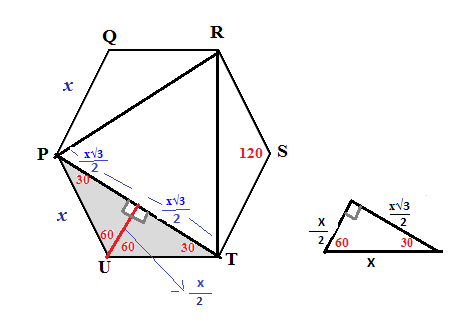AbdurRakib wrote:
In the figure shown,PQRSTU is a regular polygon with sides of lenght x.What is the perimeter of triangle PRT in terms of x?
A. (\(x\sqrt{3}\))/2
B. \(x\sqrt{3}\)
C. (3\(x\sqrt{3}\))/2
D. 3\(x\sqrt{3}\)
E. 4\(x\sqrt{3}\)
OG Q 2017(Book Question: 145)
Quote:
Roosterbooster wrote: I am completely missing something on this one
Attachment:
 hhhhhhh.png [ 10.32 KiB | Viewed 73327 times ]
hhhhhhh.png [ 10.32 KiB | Viewed 73327 times ]
Roosterbooster , I think it is easier to draw the right 30-60-90 triangles from the angle of the hexagon. See diagram.
• Dividing the equilateral triangle in the center? Doable. Not easy.
If you divide the triangle into
six (not two) congruent 30-60-90 triangles after reading what is below, it will work (but I think drawing from vertex U is easier)
You cannot solve for a side of the triangle very easily by dividing the triangle with one median. Try all three medians. Then your scale is easier to correlate with the side of the hexagon.
I think you also just forgot to divide the ratio by 2. Easy mistake.
 Find one side length of the hexagon to find perimeter• Start by dropping an altitude from one vertex to the side of the internal equilateral triangle
Find one side length of the hexagon to find perimeter• Start by dropping an altitude from one vertex to the side of the internal equilateral triangleWhat we know:
-- it is a regular hexagon
-- 120° at each vertex
Because this shape is a regular hexagon, each vertex is 120 degrees.
Total interior degrees of a polygon = 180(n-2) where n = number of sides, here, 6
Total interior degrees of this hexagon: (4 * 180) = 720°
Degree measure per vertex angle: 720 degrees/6 angles = 120 degrees per angle
-- The triangle PQR is equilateral
Because the shape is a
regular hexagon, the distance between two alternating vertices is equal.
Thus PR = RT = TP. The triangle is equilateral.
• Next step: Notice 120° at each vertex. We are always looking for 30-60-90 or 45-45-90 triangles∆ PTU is isosceles: PU = UT
Drop an altitude from vertex U.
That altitude is a perpendicular bisector
-- Now there are
two 60° angles at vertex U.
-- The altitude is perpendicular. It creates
two 90° angles. -- ∆ PTU 's
other two angles each must
= 30° 120° + small ∠ + small ∠ = 180°
Two small angles = (180° - 120° = 60° total
Each small angle = 30°
• From the two 30-60-90 triangles we can find the length of the triangle's side.There are two 30-60-90 right triangles, but their sides have been scaled down-- a 30-60-90 triangle has sides in ratio \(x: x\sqrt{3}: 2x\)
-- the ratio of sides holds, but
each part of the ratio must be divided by 2Why divide the ratio by 2?Because the sides of ∆ PTU are defined by the
hexagon's
side length,
and the hexagon's side length, we are told,
\(x\)The side of the hexagon is the side opposite the triangle's right angle. Work backwards. Label that side \(x\).
\(x\) is still opposite the right angle, but it has been scaled down.
The side opposite the 90° is usually \(2x\)
If \(2x\) has been scaled down to \(x\), we must divide all else by 2.
[Your way: You can divide the equilateral triangle into six congruent right 30-60-90 triangles, and
The side labeled \(\frac{x\sqrt{3}}{2}\) will still be opposite a 60-degree angle --]
but
we cannot label the side length opposite the 90 degree angle "\(2x\)" no matter where we draw the right triangles
It is not \(2x\). Defined by the hexagon, it is \(x\)
• Divide all three parts of the ratio-- \(\frac{2x}{2} = x\) - that is the side opposite the right angle
If I divide one part of a ratio by 2, I must divide all terms by 2, so
\(\frac{x}{2}\) = the side opposite the
30 degree angle
(normally the side opposite the 30° angle is \(x\))
Finally, \(\frac{x\sqrt{3}}{2}\) is the side opposite the
60 degree angle
(that side is based on \(x\); \(x\) is now \(\frac{x}{2}\), so \(\frac{x}{2}\) gets multiplied by \(\sqrt{3}\))
• Find the side length of the equilateral triangle, then its perimeterFrom the diagram: each side of the equilateral triangle has length
\(\frac{x\sqrt{3}}{2}\) + \(\frac{x\sqrt{3}}{2}\) = \(x\sqrt{3}\)
The perimeter? \(x\sqrt{3}\) + \(x\sqrt{3}\) + \(x\sqrt{3}\), OR
\(3x\sqrt{3}\)
Answer D
Hope it helps.




 35%
(medium)
35%
(medium)
 23%
(02:39)
wrong
23%
(02:39)
wrong  based on 3160
sessions
based on 3160
sessions






